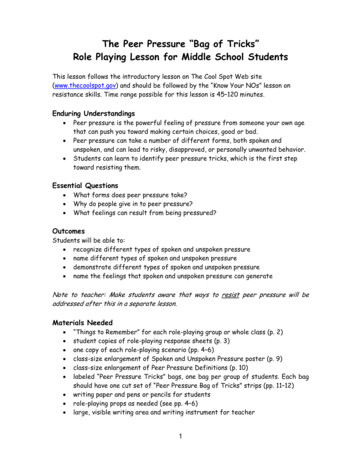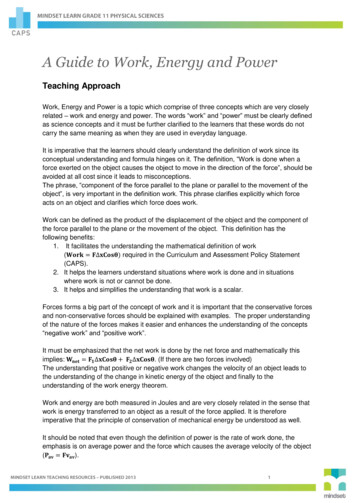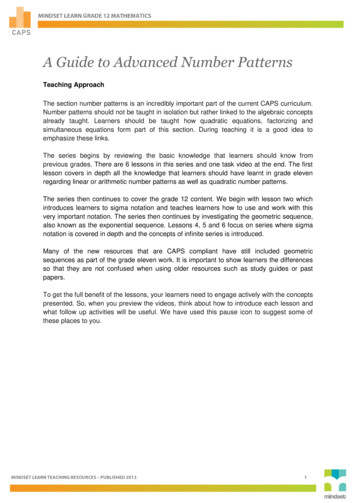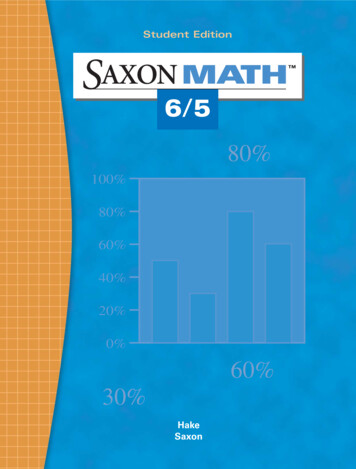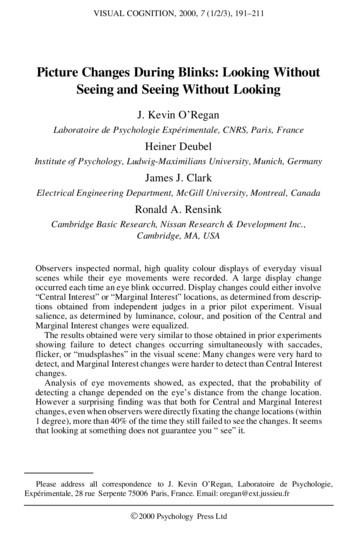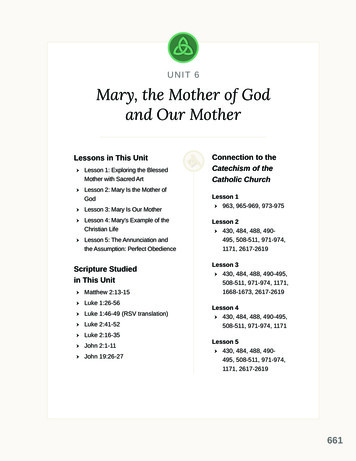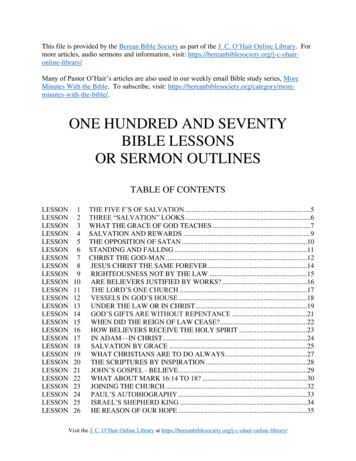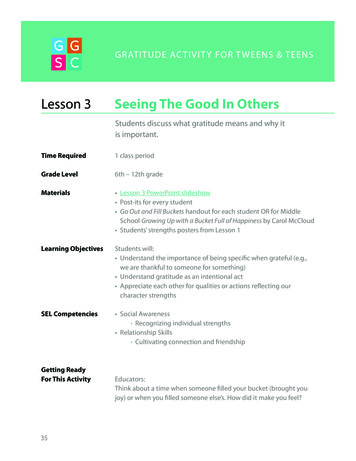
Transcription
GRATITUDE AC TIVIT Y FOR T WEENS & TEENSLesson 3Seeing The Good In OthersStudents discuss what gratitude means and why itis important.Time Required1 class periodGrade Level6th – 12th gradeMaterials Lesson 3 PowerPoint slideshow Post-its for every student Go Out and Fill Buckets handout for each student OR for MiddleSchool Growing Up with a Bucket Full of Happiness by Carol McCloud Students’ strengths posters from Lesson 1Learning ObjectivesStudents will: Understand the importance of being specific when grateful (e.g.,we are thankful to someone for something) Understand gratitude as an intentional act Appreciate each other for qualities or actions reflecting ourcharacter strengthsSEL Competencies Social Awareness- Recognizing individual strengths Relationship Skills- Cultivating connection and friendshipGetting ReadyFor This Activity35Educators:Think about a time when someone filled your bucket (brought youjoy) or when you filled someone else’s. How did it make you feel?
Lesson 3Seeing The Good In OthersHow To Do ItSlide 1Introduce the LessonGratitude ActivityLesson 3See The GoodChallengeLet’s learn what gratitude is and why itcan make us feel better. Introduce the lesson.- Today the focus is on expressing gratitude, but let’s start off witha quick review Slide 2ExpressingGratitudeGratitude ActivityLesson 3Expressing GratitudeGratitude is a socialglue; it holds relationships together. If you like, ask a few volunteers to share something they wrote intheir gratitude journals for homework.36
Lesson 3Seeing The Good In OthersSlide 2ExpressingGratitude (cont’d) Tell students:- Expressing gratitude, or saying “thank you,” is critical forrelationships. It helps each person recognize the otherperson’s efforts and makes the other person feel appreciated.When we express gratitude, we communicate to theimportant people in our lives how they matter to us AND,over time, we get closer to these people because they helpus reach significant goals in our lives. It’s glue for who andwhat matters!Slide 3GratitudeIs A ChoiceGratitude ActivityLesson 3Gratitude Is A ChoiceYou choose how you think.It’s your choice to focus on goodthings or bad things in life.You also choose how you act.It’s also your choice whether you want to dothings that lift others up or bring them down. Do the following quick experiment:- Look around the room for 20 seconds to find all the bluethings that you can see (wait 20 seconds).- OK, what did you see that was green? After students pointout that you said ‘blue’, reply: “But you looked around, right?So why can’t you tell me what was green?”- This illustrates how we expand what we focus on in ourminds, while everything else (the green) fades away. Ourbrains rewire this way!37
Lesson 3Seeing The Good In OthersSlide 3GratitudeIs A Choice (cont’d) Then explain to students:- It’s important to realize that you choose how you look at lifeand what focus you can take throughout the day.You can spend all of your time and energy thinking aboutall the things that go wrong in life, looking atpeople’s negative characteristics, and doing things to feelbetter about yourself at the expense of others.- Or you can choose to appreciate all the good things that youhave in your life, recognize people’s positive characteristics,and do things that make others feel better about themselves.Slide 4Bucket Filling(Part 1)Gratitude ActivityLesson 3“Bucket Filling”Things that lift others up(or “fill their buckets”) include: Being friendly Expressing gratitude Complimenting them ontheir strengths/talents Encouraging them topursue goals Showing compassion Read either the “Go and Fill Out Buckets MS-HS” handout orMcCloud book on Bucket Filling.- Having our buckets full not only makes us happy. It also makes usstrong because it’s like having a tank full of gas. With full bucketswe keep trying new options to solve problems rather than quit,we can keep going rather than give up. A full bucket feels goodnow, but keeps us strong when we need to be, too.38
Lesson 3Seeing The Good In OthersSlide 4Bucket Filling(Part 1) cont’d Ask students for examples of ways people have filled their buckets.Discuss with students:- These are special people who CHOSE to be nice to you.How do they make you feel? Do they make you feelgrateful? You, too, can CHOOSE to appreciate these specialpeople in your life.Slide 5Bucket Filling(Part 2)Gratitude ActivityLesson 3“Bucket Filling”Practice expressing kindnesstowards your classmates.You can: Tell them thank you for doingsomething kind for you Compliment them on one oftheir strengths or talents Commend them for a behaviorthat exemplifies one of theircharacter strengths Now it’s time for students to fill each other’s buckets. Introducethe activity during which students will leave post-it “Thanks”that acknowledge/compliment others’ character strengths ontheir posters. Teachers should first share their own strengths poster.- You may all know about this strength of mine, but maybe youdidn’t know about this one. What are ways you’ve noticedthem? (Be sure to thank students who offer ideas.) Provide some examples of post-it thanks that acknowledge others’strengths:- Thanks for helping me carry my project into school. Youshowed kindness.39- I appreciate your jokes yesterday. Your humor helped pick meup. Thanks.
Lesson 3Seeing The Good In OthersSlide 5Bucket Filling(Part 2) cont’d- Thanks for your help on the assignment. You showedteamwork. Challenge students to look for the good in others byacknowledging each other’s strengths. (Note: To make sure thateach student gets something written about him or her, you canhave students draw names or turn to a neighbor on one side.)- This helps us appreciate the gifts we all have to share and thegood qualities of friends.- Allow students several quick occasions to fill buckets tocultivate a sense of connection to peers and to improveclassroom climate. Introduce the homework, which is to write about and thank peoplewho noticed or supported a strength or talent of yours.- Write about a time when someone did NOT notice you ora talent of yours. How did that make you feel? Then writeabout a time someone DID notice you or a talent of yours.How did that make you feel?Reflection AfterThe ActivityMake and share a thank you card with a person whonoticed you or your talent (mention WHAT THIS PERSONDOES THAT MATTERS PERSONALLY to you, the person’sEFFORTS ON YOUR BEHALF, and HOW THIS PERSON’SBEHAVIOR MAKES YOU BETTER). Ask students to reflect on how it felt to have someoneacknowledge their strengths and to acknowledge another person’sstrengths. Students might also identify one person in their lives whose“bucket” they would like to fill sometime in the next 24 hours.40
Go Out And Fill BucketsIdeas about Bucket Filling from “How Full is Your Bucket” by Tom Rath and “GrowingUp with a Bucket Full of Happiness” By Carol McCloudYou can read excerpts from the book or the entire book, but here is the main idea. The Theory of the Dipper and the Bucket. Each of us has an invisible bucket. It isconstantly emptied or filled, depending on what others say or do to us. When ourbucket is full, we feel great. When it’s empty, we feel awful. Each of us also has aninvisible dipper. When we use that dipper to fill other people’s buckets - by sayingor doing things to increase their positive emotions – we also fill our own bucket. Butwhen we use that dipper to dip from other’s buckets – by saying or doing things thatdecrease their positive emotions – we diminish ourselves as well. Like the cup thatrunneth over, a full bucket gives us a positive outlook and renewed energy. Everydrop in that bucket makes us stronger and more optimistic. But an empty bucketpoisons our outlook, saps our energy, and undermines our will. That’s why everytime someone dips from our bucket, it hurts us. So we face a choice very momentof every day: We can fill one another’s buckets, or we can dip from them. It’s animportant choice – one that profoundly influences our relationships, productivity,health, and happiness. (p.15 How Full is Your Bucket) Go out and fill buckets. Give compliments to people, encourage them. When youare at school, look around and see if there is someone who looks like he or shemay not be having a very good day and do something nice for that person, such asinviting him or her to hang out. Try each day to fill other people’s emotional buckets. Avoid taking from another person’s bucket. We take from others when we criticizeor bully them or do anything else that brings someone down rather than builds himor her up. Those who have a need to take from someone else’s bucket are really justtrying to fill their own empty bucket! Fill a bully’s bucket, too. Those individuals who take from others (bully, criticize,or treat negatively) are the people who usually need the most bucket filling. Theyare lacking love and acceptance in their own lives. Unfortunately, treating othersnegatively never gives us what we are lacking. According to Carol McCloud, we cannever fill our own buckets by taking from the bucket of another person. Even thoughit feels like someone doesn’t deserve it, do something to fill this person’s bucket byPAGE 1 GO OUT AND FILL BUCKETS
Go Out And Fill Bucketsgiving him or her a compliment, smile, or some other positive gesture that helpseveryone feel better. Remember your loved ones. What about filling the buckets of people we know andlove? What kinds of things can we do for our parents, siblings, and friends to showthem how special they are to us? Doing this really makes you think about how muchyour loved ones do for you and how much they mean to you. Carol encourages us tothink of more gestures we can make to show them how special they are. What canyou do to fill the buckets of your loved ones?PAGE 2 GO OUT AND FILL BUCKETS
- Having our buckets full not only makes us happy. It also makes us strong because it’s like having a tank full of gas. With full buckets we keep trying new options to solve problems rather than quit, we can keep going rather than give up. A full bucket feels good now, but k




